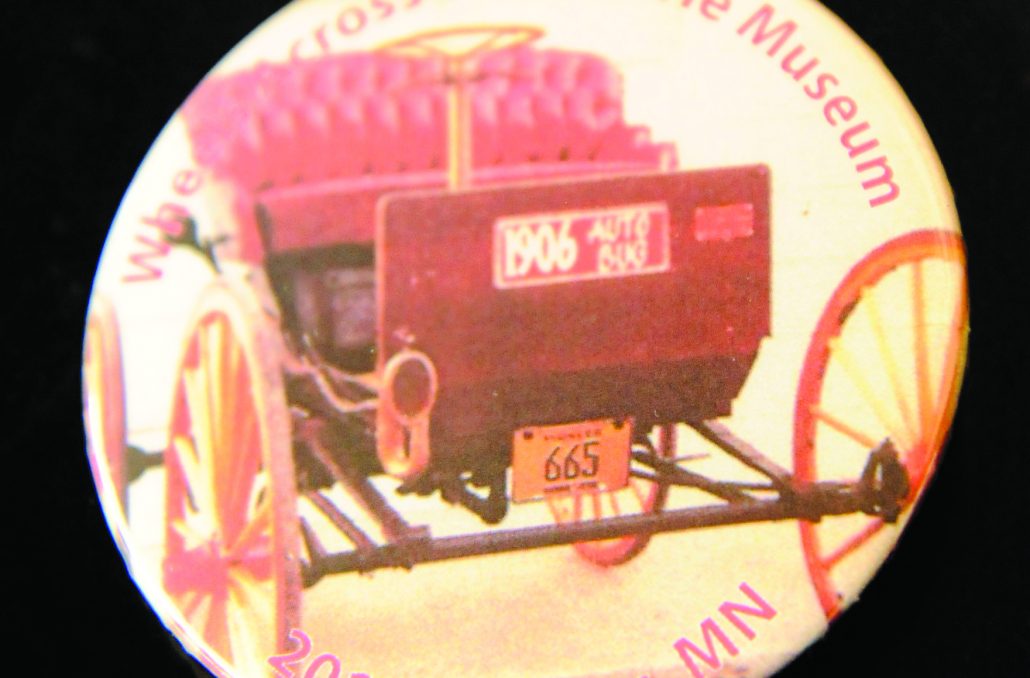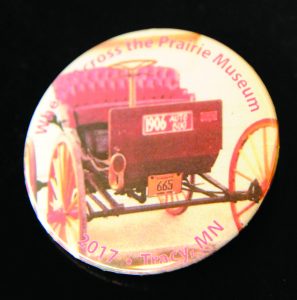

By Seth Schmidt
Tracy’s “first automobile” is rolling again …
On the Wheels Across the Prairie Museum’s 2017 Box Car Days button, that is.
The photo button shows the early 20th-century Auto-Bug that Merrill and Alice Firebaugh drove in the Box Car Days parade for many years.
“They would be thrilled about it,” remarks their daughter, Marcy Firebaugh Schramm, of the Box Car Days button.
The vintage automobile is one of two (and possibly three) Auto-Bugs purchased by prominent early Tracy businessman D. H. Evans, and were among Tracy’s earliest automobiles. Firebaugh salvaged his Auto-Bug from the second-floor of a downtown building where Evans once operated a hardware and implement store. When Firebaugh bought the Auto Bug in 1946, the machine was missing some of its pieces, possibly because it had supplied spare parts for the other Auto Bug. But over a 10-year period, Firebaugh got the Auto-Bug running again and drove it in the Box Car Days Parade for more than 30 years.
The Auto-Bug is now displayed at the museum. Museum volunteers felt it was fitting to have the Firebaughs and their Auto Bug on the button, since the Firebaughs were also devoted museum volunteers in its early years.
The Auto Bug buttons are on sale for $6, a price that offers unlimited admissions for one person to the museum over the Box Car Days weekend.
• • •
In a 1989 interview with the Headlight-Herald, Firebaugh said that when he first came to Tracy in 1945, longtime residents still recalled Evans driving an Auto-Bug. Firebaugh said that it was his understanding that the Evans eventually gave this car to his son, Tracy. According to an unconfirmed story, the Auto-Bug was later sold to MGM Studios in Hollywood, California. The vehicle may have been driven by Red Skelton in the movie, “Excuse My Juice.”
Firebaugh said that some locals felt the Evans oroginally obtained three Auto Bugs. What happened to the third Tracy Auto-Bug, if it existed, is unknown.
• • •
The Firebaughs moved to Tracy following World War II, when Merrill established a welding business on Hwy. 14. By then, the Evans Hardware store had become a meat market owned by Walt Moline. While doing a job for Moline, Firebaugh discovered the Auto Bug in storage above the meat market.
A placard in the museum tells the story: “While working above the Malone Meat Market, Merrill noticed an old car in very bad condition. He wanted it. He thought he couldn’t afford it because he was just starting his welding and machine shop business.
“So Merrill told his wife to ask Walt how much he wanted for the old car the next time she was in the meat market. Alice asked and Walt said, ‘Well, does he know he would have to take it apart and haul it down from upstairs?’ Alice said Merrill knew that. Walt said, ‘Well, if he gives me $5 he can have it.’
“Merrill didn’t sleep that night and the next morning he put a $5 bill on Walt’s counter and said he was going to take the car apart and haul it out.’”
• • •
So began Firebaugh’s painstaking efforts to restore the car.
“The work and labor and material on the engine I did myself in our shop,” Firebaugh recalled in 1989. Over the years, we spent many, many hours fashioning parts, mostly by guess, knowing what the part was to do, but not what it should look like from the original, I’ve always enjoyed taking things apart to see how they would work. If we didn’t have our own welding and machine shop, I could never have afforded to rebuild the missing parts and make it run.”
Only a few aspects of the restoration—new tires, and re-upholstered seats— were not accomplished in Firebaugh’s shop.
For three decades, the Firebaughs and their Auto- Bug appeared in almost every Box Car Days Parade. The Firebaughs also took the car to numerous other parades and car shows. Adding to the fun, both wore period costumes as they drove through parades.
• • •
The Auto-Bug’s two-cylinder engine is rated at a hefty six-horse power, and has a chain link drive. A Firebaugh memoire said the car was capable of 25 MPH, but runs better at slower speeds. A hand-operated brake slowsed and stoped the vehicle. Since the car’s springs, body, axle and gears were all connected together, problems could arise if too much weight got on the car. Firebaugh described how parade clowns would sometimes hop onto the Auto- Bug’s trunk for a laugh, but unwittingly stall the car.
“The extra weight spreads the axles apart somewhat and enough that the drive chain will tighten up and stop the car…It’s all in fun, but the clowns don’t know what it does to the car,” Firebaugh wrote.
The driver controlled two pedals on either side of the steering column. The left pedal put the car in low gear, the right pedal reverse. Pulling a long lever to the right of the steering wheel put the car into high gear. A hand throttle fed gas to the engine cylinders.
The vehicle’s wheels look similar to those used on a horse-pulled wagon or carriage, except that they are fitted with hard-rubber tires. “Auto-Bug” is thought to be short for “Auto-Buggy.”
The Firebaugh vehicle was first thought to be an 1898 Oldsmobile. Later, antique car experts determined that the car was an “Auto-Bug,” manufactured by the Auto Bug Company of Norwalk, Ohio, with a model year of 1906.
However, an on-line posting by the Norwalk Chamber of Commerce, states that the Auto-Bug Company produced cars in 1909 and 1910, before becoming the Norwalk Motor Car Company. The company went out of business prior to World War I.
The Firebaugh car is missing a fold-down cover, as well as two headlamps that were positioned on either side of the steering column.
• • •
Merrill Firebaugh died in 1994 at age 91. Alice passed away in 2000 at age 90.
Marcy Firebaugh, a 1964 Tracy graduate who now lives in Plymouth, states that except for his family, her dad treasured his old car more than anything else in life.
Evans, the car’s first owner, was the Farmer-Labor party’s nominee for governor in 1918. The Tracy businessman finished second to incumbent Republican J. A. Burnquist in a three-way state race. Burnquist out-polled Evans, 166,515 to 111,948 votes. With Democrat Fred Wheaton getting 76,793 votes.
The Auto-Bug that Evans drove likely would have been parked behind the Victorian mansion that was built at the corner of Second and Emory streets. (now the Park Place Apartments). The Evans house was moved to a lot west of the present Zion Lutheran Church in the 1936s and converted into apartments. The once grand house is now vacant.
